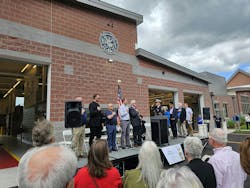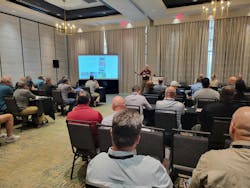Developing and Building Community Support for New Fire Stations
When a public safety agency needs to purchase new property, relocate, expand, renovate, or construct a new station, where does the funding come from? Some districts or municipalities may use bonds, capital improvement budgets, or commercial borrowing as funding avenues. A bond is a funding mechanism used by municipalities or other taxing authorities to raise money for capital projects. For bond funding, the borrower asks taxpayers for permission to borrow money using future tax revenue as collateral.
Initial questions
Financing a capital project, buying land, or utilizing municipality-owned land raises key questions. How do we plan the process or obtain public support and approval for funding? What steps do you take to minimize possible defeat at the ballot box?
Start by organizing a small committee to provide leadership and establish a consulting relationship with a qualified architectural firm, which can help define the project’s scope, size, probable cost, and schedule. Professional services may include an analysis of a current facility, conceptual design of a renovated or new facility, or a land search for new property.
Project budgeting and cost estimation will help identify the amount of money needed for the facility and ancillary costs. Leveraging public opinion is a powerful way to engage the community, influence commissioners, and gain political support for funding approval. However, losing public support is almost always a fatal blow to a project.
Preparation
Once your project is defined enough to illustrate its purpose, size, scope, and budget, it’s time for public engagement. It’s vital to get your own department members in favor. Internal dissent will not help convince your community a project is viable, and unanimous internal support is a strong starting point for any project.
Throughout the process, committee members should hold information-gathering meetings and make regular progress presentations to department stakeholders, elected officials, and the public. A qualified architect experienced in garnering support can work with your committee in numerous ways. In addition to holding informational meetings, producing action plans, generating timelines, and developing budgets, your technical experts should also help you create infomercials, generate press releases and articles, develop a blog or website section, and more, depending on the best mediums in which to reach your community.
The key to the entire support process is accurate, consistent communication. This means squelching the rumor mill before it has a chance to get started. Market the project to your taxpayers early and don’t hide what you’re planning. Anticipate questions regarding costs and need. How will this affect my taxes? Why do we need this? Why move?
As an architect, I have hosted many public presentations where the attendees didn’t know the extensive responsibilities and training required for all types of responders or even that their firefighters were volunteers.
When using future taxes for project payment, you must prepare pertinent information for your taxpayers, including:
- Current total tax rate
- Current fire or public safety tax rate
- Future fire or public safety tax rate
- Total fire or public safety taxes collected during the last fiscal year
- Total taxable assessed value for the taxing district
- Average assessed value for residences and businesses
Adjusting the amount borrowed, interest rate, and payback period changes the financing criteria and how taxes will be affected. When planning to use bonds or capital budgets for future funding, be sure to account for project cost escalation to avoid budget shortfalls during the design or construction phases.
Communicating the needs
To help keep information consistent, create an information package with talking points to help department members speak knowledgeably and keep the facts straight. This information can also be given to the local newspaper or television station as a press release, or included on a website or blog. Create a task list for those willing to help:
- Meet with reporters for an article
- Set up interviews with local radio or TV
- Provide informational pamphlets at public events and spaces
- Give station tours to raise awareness of some of the existing problems
- Write letters to the editor to help them understand the need
All these tasks should be controlled and approved by the committee for accuracy. When disseminating project information, identify supporters and detractors. Meet with detractors to discuss their issues, as they may become supporters simply by hearing straight answers to their questions. Meet with supporters to ensure that they’ll attend public meetings and vote.
Letters or interviews by citizens who have been aided by the department can be very effective, as can the support of key community figures, religious leaders, and politicians.
Education at public meetings
For public meetings, compile additional background data:
- The history of your department/district
- The history of your current facility
- Site location rationale, if applicable
- Response times
- Comparable tax rates for surrounding communities or districts
- Data concerning the amount of time required by responders for training, drills, and emergency calls
Invite the media and plan for a minimum of two public informational meetings, which your architect can coordinate and moderate. If the first meeting raises questions or generates negative reactions, regroup, plan, and use the second meeting to address the issues.
Develop an agenda to ensure that all important matters are covered. Present the architectural plans, budget, timeline, value engineering ideas, and tax information.
Hold the vote
If possible, do not schedule your vote too close to another major community bond vote or tax issue. Avoid holding your vote close to Tax Day (April 15) or a federal holiday.
Once a bond or municipal vote is approved, you have both financial backing and public authorization to move forward with your project. However, if voters reject it, don’t lose faith. Begin the process again. Don’t automatically assume that you must reduce the scope or budget of the project. Carefully search out and analyze the reasons why voters turned down the project.
Then, revise your approach to address and incorporate specific issues and objections. Let the public know that you’ll try again with specific alterations on the pertinent issues. If you address these concerns, you may still be able to realize the original scope. Continue to educate voters and encourage supporters to show up.
After a successful public vote, use the momentum to your advantage. Don’t disband the committee. Continue to advocate the project to the community and work with your architect to create the final design and documents necessary to build your facility. You’ve got your support and financing approved – now get that project underway!
About the Author

Dennis A. Ross
Dennis Ross, AIA, is a Technical Advisor and past Emergency Services Market Director at H2M architects + engineers. Previously, he was a founder and co-owner of a nationally recognized, award-winning firm exclusively dedicated to the design of emergency response facilities across North America. He has over 40 years of focused experience in construction and development, which allows him to assess projects from multiple points of view.
He is NCARB certified; a member of the American Institute of Architects, National Fire Protection Association (NFPA), and the International Code Council; licensed in 14 states; and an honorary member of the Kingston Fire Department. His expertise in public forums, project management, land use, budgeting, construction and focus on solutions to difficult problems has enabled him to knowledgeably write and speak on a variety of emergency services station design issues. Dennis has authored many articles and presented at even more conferences. In 2001, he received the Business Council of New York State’s and National Federation of Independent Business’ annual award for “New York State Small Business Advocate of the Year.”
Dennis is currently serving on the NFPA Technical Committee on “Emergency Responders Occupational Health,” which is tasked with developing a new Standard for Contamination Control, NFPA 1585. Dennis led the task group for Chapter 5, Emergency Services Organization Facilities. In 2022, he was appointed to the NFPA - Architects, Engineers, Building Officials (AEBO) commitee as an Executive Board Member.

